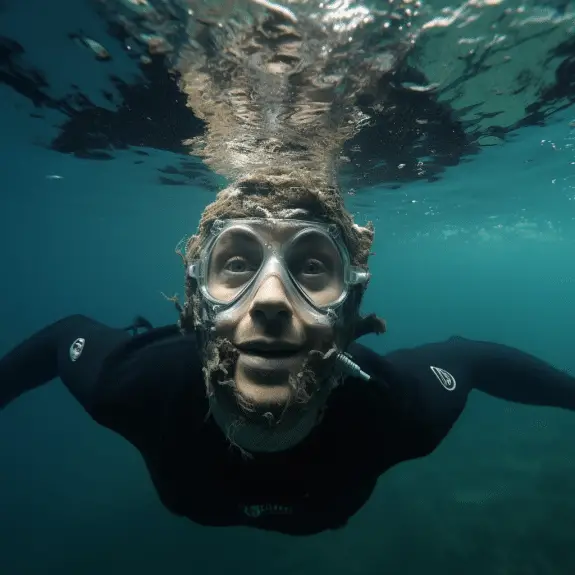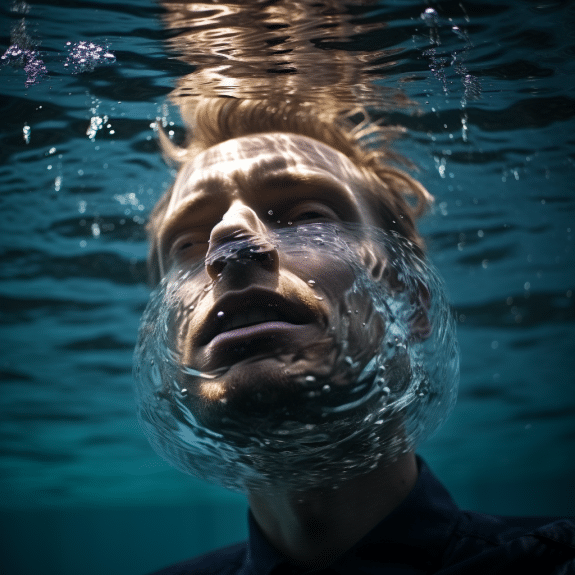Face split diving is one of those underwater techniques that sound so cool but can feel a bit intimidating when you first hear about it. Imagine this: you're gliding through the water, completely calm, and then suddenly your face splits into two as you dive deeper into the ocean. Okay, not literally, but that's kind of what it feels like when you master this skill. It's like unlocking a hidden door to the underwater world, where you can explore depths you never thought possible. Whether you're a seasoned diver or just starting out, understanding the intricacies of face split diving can take your diving experience to the next level.
But hold up, before we dive headfirst into the deep end, let's break it down. Face split diving isn't just about looking cool underwater. It's a technique that requires precision, practice, and a solid understanding of your body's relationship with the water. It's like learning a new language, but instead of words, you're using your body to communicate with the ocean. So, if you're ready to uncover the mysteries of this fascinating technique, buckle up because we're about to take a deep dive into the world of face split diving.
Now, I know what you're thinking. "Is face split diving really that complicated?" The short answer is yes and no. It's not rocket science, but it does require some finesse. Think of it like riding a bike for the first time. At first, it might feel a little wobbly, but with practice, you'll be cruising like a pro. So, let's get started by exploring the basics and uncovering the secrets that make this technique so captivating.
Read also:Exodus Tyson Death Scene A Tragic Event In Mike Tysons Life
What Exactly is Face Split Diving?
Let's start with the basics. Face split diving is a technique used by divers to transition smoothly between different depths while maintaining control over their buoyancy. It's all about how your face interacts with the water as you dive. Picture this: you're descending, and as you go deeper, your face splits the water effortlessly, creating a seamless transition. It's not just about looking smooth; it's about efficiency and safety. By mastering this technique, you can conserve energy, reduce drag, and enhance your overall diving experience.
Face split diving isn't just for show. It's a practical skill that every diver should have in their toolkit. It allows you to navigate the underwater world with confidence and precision. Whether you're exploring coral reefs or diving into the depths of a shipwreck, this technique can make all the difference. So, if you're ready to learn more, let's dive deeper into the world of face split diving.
Why Should You Care About Face Split Diving?
Okay, so you might be wondering, "Why should I even bother learning about face split diving?" Well, here's the thing: it's not just about the technique itself. It's about the benefits it brings to your diving experience. First off, it improves your buoyancy control. By mastering this technique, you can maintain a steady position in the water, which is crucial for avoiding accidental contact with marine life. Plus, it makes you look like a total pro, and who doesn't want that?
But it's not just about looking good. Face split diving can also enhance your safety. By understanding how your body interacts with the water, you can avoid common diving mishaps like rapid ascents or descents. It's like having a superpower that keeps you safe and in control. So, if you're ready to elevate your diving game, this technique is definitely worth exploring.
Breaking Down the Technique: Step by Step
Now that we've covered the basics, let's break down the technique step by step. First things first, you need to focus on your breathing. Controlled breathing is key to maintaining buoyancy and ensuring a smooth descent. Start by taking deep, steady breaths and exhaling slowly as you begin your dive. This will help you relax and stay focused.
Next, pay attention to your body positioning. Your head should be in a neutral position, with your eyes looking straight ahead. As you descend, imagine your face splitting the water like a knife cutting through butter. Keep your arms relaxed at your sides and your legs slightly apart to maintain stability. It's all about finding the right balance and letting your body flow with the water.
Read also:Unveiling The Phenomenon Of Sophie Raid A Comprehensive Guide
Mastering the Art of Buoyancy Control
Buoyancy control is the name of the game when it comes to face split diving. Think of it like a dance between your body and the water. To master this technique, you need to develop a keen sense of awareness about how your body reacts to changes in pressure and depth. Start by practicing in shallow water, where you can focus on your technique without the added stress of deeper dives.
One of the best ways to improve your buoyancy control is to use a buoyancy control device (BCD). This handy tool allows you to adjust your buoyancy with ease, making it easier to maintain a steady position in the water. As you practice, pay attention to how your BCD interacts with your body and make adjustments as needed. It's all about finding the sweet spot where you feel completely at ease in the water.
Common Mistakes to Avoid
Now, let's talk about some common mistakes divers make when learning face split diving. One of the biggest pitfalls is rushing the descent. It's tempting to want to dive straight down, but this can lead to loss of control and increased risk of injury. Instead, take your time and focus on maintaining a steady pace. Remember, it's not a race.
Another common mistake is overcompensating with your BCD. Some divers tend to add too much air or release too much, which can throw off their buoyancy. The key is to make small adjustments and observe how your body responds. Practice makes perfect, so don't be discouraged if it takes a few tries to get it right. Just keep at it, and you'll be splitting faces like a pro in no time.
The Science Behind Face Split Diving
So, what's the science behind this fascinating technique? Well, it all comes down to physics and hydrodynamics. When you dive, your body creates resistance against the water, which can affect your speed and efficiency. By mastering face split diving, you can reduce this resistance and move through the water with greater ease. It's like cutting through the water instead of pushing against it.
Another important factor is the role of pressure changes as you descend. As you go deeper, the pressure increases, which can affect your buoyancy and breathing. Understanding how your body responds to these changes is crucial for maintaining control. By practicing face split diving, you can develop a deeper understanding of these principles and become a more confident diver.
Understanding Water Resistance and Streamlining
Water resistance is a key factor in face split diving. To minimize resistance, you need to focus on streamlining your body. This means keeping your body as straight and narrow as possible, with your arms relaxed at your sides and your legs slightly apart. Think of it like a torpedo cutting through the water. The more streamlined you are, the easier it will be to maintain control and conserve energy.
Streamlining isn't just about looking cool; it's about efficiency. By reducing resistance, you can move through the water with less effort, which means you'll have more energy for exploring the underwater world. So, if you're ready to become a streamlined diving machine, keep practicing and refining your technique.
Training and Practice Tips
Now that you understand the basics, let's talk about training and practice. The key to mastering face split diving is consistency. Set aside time each week to practice your technique in a controlled environment, like a pool or shallow dive site. Start with simple exercises, like practicing your breathing and body positioning, and gradually work your way up to more advanced techniques.
Consider enrolling in a diving course to get personalized feedback from an instructor. They can help you identify areas for improvement and provide guidance on how to refine your technique. Additionally, practicing with a buddy can be incredibly beneficial. Having someone to dive with can provide motivation and support as you work on mastering this skill.
Setting Realistic Goals and Tracking Progress
Setting realistic goals is crucial for staying motivated and tracking your progress. Start by setting small, achievable goals, like improving your buoyancy control or increasing your dive time. As you achieve these goals, gradually set bigger challenges for yourself. Remember, progress takes time, so be patient and celebrate your successes along the way.
Tracking your progress is also important. Keep a log of your dives, noting any improvements or challenges you encounter. This will help you identify patterns and areas for improvement. Plus, it's a great way to reflect on how far you've come and stay motivated to keep pushing forward.
Safety First: Tips for Safe Face Split Diving
Safety should always be your top priority when diving. Before you attempt face split diving, make sure you're familiar with basic diving safety protocols. This includes checking your equipment, monitoring your air supply, and staying aware of your surroundings. Always dive with a buddy and communicate clearly before and during your dive.
When practicing face split diving, start in shallow water where you can focus on your technique without the added stress of deeper dives. Gradually work your way up to deeper depths as you become more comfortable with the technique. Remember, it's always better to err on the side of caution and take your time to ensure a safe and enjoyable diving experience.
Conclusion: Take the Plunge
Face split diving is a fascinating technique that can take your diving experience to the next level. By mastering this skill, you can improve your buoyancy control, enhance your safety, and explore the underwater world with confidence and precision. So, if you're ready to take the plunge and uncover the secrets of face split diving, start practicing today.
But don't stop here. Dive deeper into the world of diving and continue learning new techniques and skills. The more you know, the better diver you'll become. So, whether you're exploring coral reefs or diving into the depths of a shipwreck, remember to stay safe, have fun, and keep pushing your limits. And don't forget to share your experiences with fellow divers and inspire others to take the plunge. Happy diving!
Table of Contents
- What Exactly is Face Split Diving?
- Why Should You Care About Face Split Diving?
- Breaking Down the Technique: Step by Step
- Mastering the Art of Buoyancy Control
- Common Mistakes to Avoid
- The Science Behind Face Split Diving
- Training and Practice Tips
- Setting Realistic Goals and Tracking Progress
- Safety First: Tips for Safe Face Split Diving
- Conclusion: Take the Plunge


